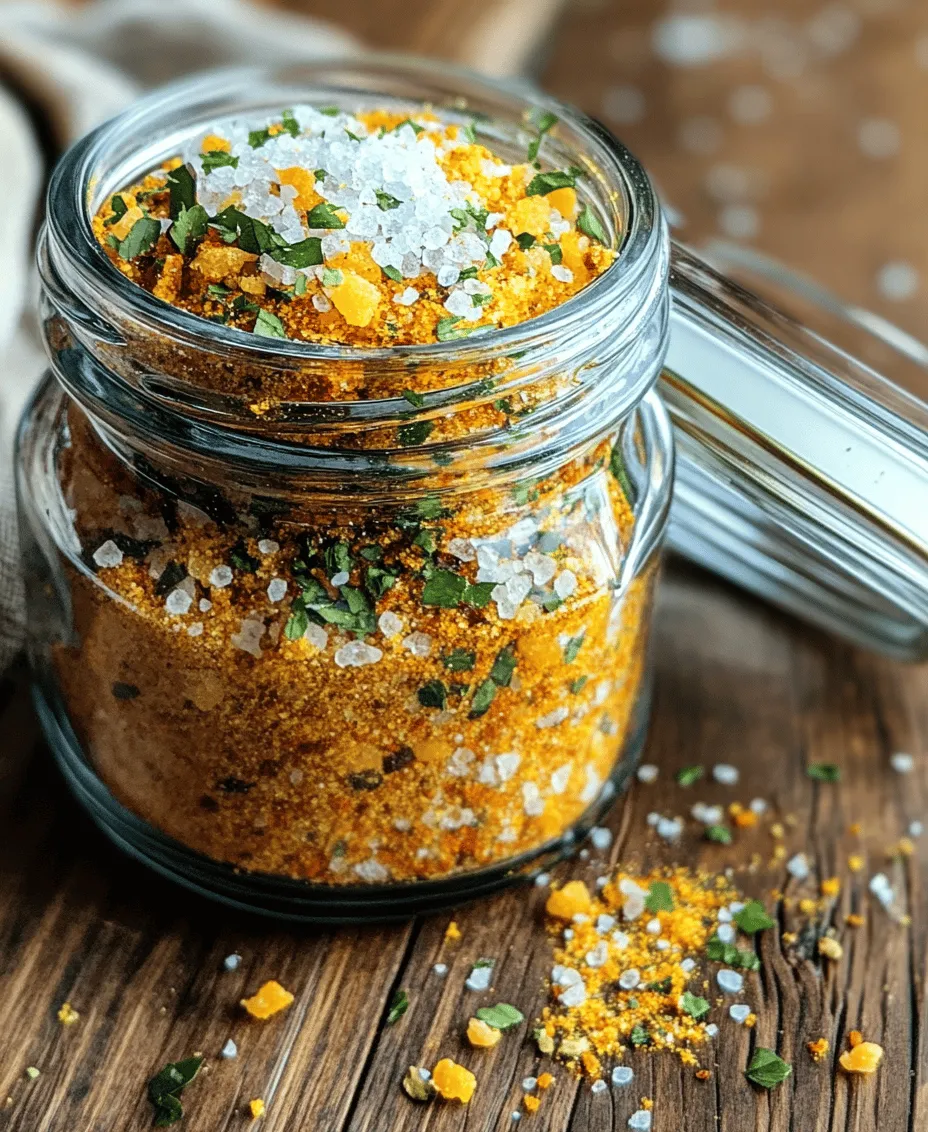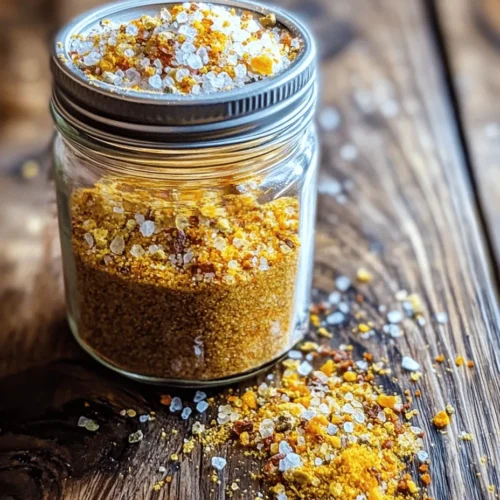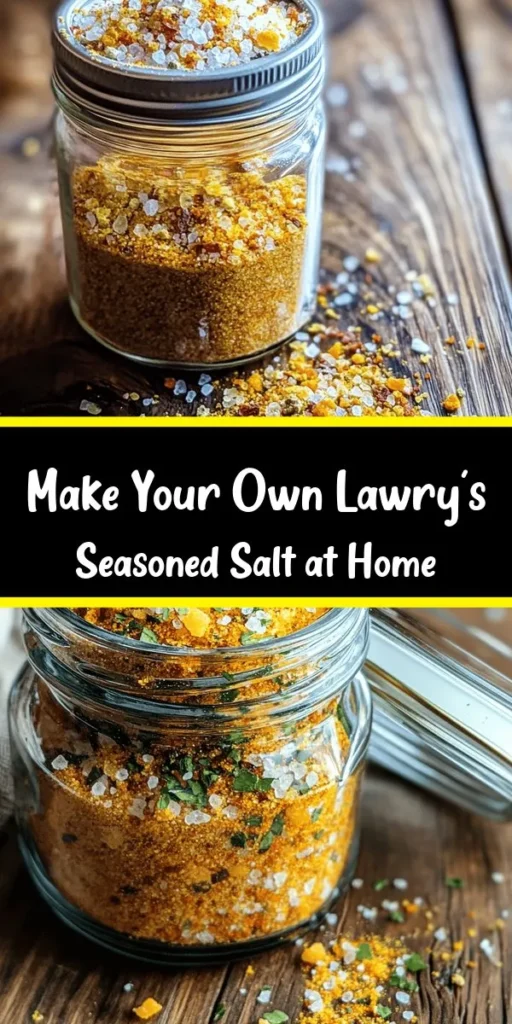Introduction
If you’ve spent any time in the kitchen, chances are you’ve come across Lawry’s Seasoned Salt. This iconic blend of spices has been a staple in American households for decades, adding a burst of flavor to everything from meats to vegetables. Known for its unique flavor profile, Lawry’s has carved out a niche in various cuisines, elevating simple dishes into something truly special. Its versatility makes it a favorite among home cooks and professional chefs alike, who appreciate the convenience it offers.
However, have you ever considered making your own version of Lawry’s Seasoned Salt at home? Crafting your own seasoning mix comes with a multitude of benefits. Firstly, there’s the undeniable freshness that comes from using recently sourced ingredients. Store-bought options often contain preservatives and artificial flavors that can detract from the pure taste of your food. By creating your own seasoned salt, you gain complete control over what goes into the mix, allowing you to tailor it to your personal preferences and dietary needs. You can even adjust the saltiness, sweetness, and spiciness to perfectly suit your palate.
In this article, we will guide you through the delightful process of making your own flavorful homemade Lawry’s Seasoned Salt. This simple recipe not only enhances the flavors of your favorite dishes but also opens the door to experimentation. Imagine sprinkling your custom blend on grilled chicken, roasted vegetables, or even popcorn! Let’s dive into understanding seasoned salt, its origins, and the ingredients that make this homemade version shine.
Understanding Seasoned Salt
What is Seasoned Salt?
Seasoned salt is a versatile seasoning blend that combines salt with various herbs and spices to enhance the flavor of food. Its primary purpose is to offer a convenient way to season dishes without the need to individually measure out multiple spices. The blend typically contains salt, sugar, and a variety of spices, making it a one-stop solution for adding flavor to meats, vegetables, soups, and more.
The Origins and History of Lawry’s Seasoned Salt
Lawry’s Seasoned Salt was first introduced by Lawry’s, a brand that has been synonymous with flavor since 1938. The seasoning was created by the Lawry family, who operated a popular prime rib restaurant in Beverly Hills, California. Customers were drawn to their signature seasoning, which quickly became a favorite. Over the years, Lawry’s Seasoned Salt gained immense popularity and became a culinary staple in kitchens across the United States.
The distinctive flavor profile of Lawry’s Seasoned Salt is attributed to its blend of spices that not only complement but enhance the natural flavors of food. The seasoning mix has become a must-have for those looking to add a quick flavor boost to their meals without the lengthy process of measuring and mixing individual spices.
Homemade vs. Store-Bought Seasoned Salt
While store-bought seasoned salt is convenient, making your own at home has several advantages that can elevate your cooking to the next level. One of the most significant benefits of homemade seasoning is the ability to customize the ingredients according to your taste preferences. You can experiment with different ratios or add unique spices to create a blend that is uniquely yours.
Additionally, homemade seasoned salt can be healthier than its store-bought counterpart. Many commercial blends contain anti-caking agents, preservatives, and artificial flavors that you may wish to avoid. By making your own, you can opt for only the freshest and healthiest ingredients, ensuring you’re not only enhancing the flavor of your dishes but also consuming better-quality food.
Ingredients Breakdown
Creating your own Lawry’s Seasoned Salt requires a handful of simple ingredients, each playing a crucial role in achieving that iconic flavor. Below is a detailed description of each ingredient and its contribution to the overall blend:
Kosher Salt
Salt is the foundation of any seasoning mix, and kosher salt is a favored choice among chefs for its coarse texture and ease of use. It enhances the flavor of dishes by drawing out the natural tastes of the ingredients. Using kosher salt in your homemade Lawry’s Seasoned Salt ensures that you achieve the perfect balance of seasoning without overwhelming your food.
Granulated Sugar
While it may seem unusual to include sugar in a seasoning blend, granulated sugar plays a vital role in balancing flavors. The subtle sweetness helps to counteract the saltiness and enhances the overall taste of the blend. It also contributes to a rich caramelization when used in cooking, making your dishes even more delicious.
Garlic Powder and Onion Powder
Garlic powder and onion powder are essential aromatics that add depth and complexity to the flavor profile of your seasoned salt. These ingredients bring a savory richness that enhances meats, vegetables, and even soups. Their convenience allows you to enjoy the robust flavors of garlic and onion without the hassle of chopping fresh ingredients.
Paprika
Paprika is not only a beautiful addition to your seasoning mix, lending a warm color, but it also adds a mild sweetness that rounds out the flavor. Depending on the variety of paprika you use—sweet, smoked, or hot—you can influence the overall taste of your seasoned salt. For a classic Lawry’s flavor, sweet paprika is often the preferred choice.
Turmeric Powder
Turmeric powder is known for its vibrant color and numerous health benefits, including anti-inflammatory properties. In your homemade seasoned salt, it contributes a warm hue and a subtle earthiness that enriches the flavor profile. Turmeric also adds a unique twist that sets your blend apart from commercial options.
Cornstarch
Cornstarch serves a specific purpose in this seasoning mix: it acts as an anti-caking agent. When making a large batch of seasoned salt, it’s essential to ensure that the mixture remains free-flowing and doesn’t clump together. Adding cornstarch helps maintain the texture and usability of your blend, ensuring that it stays fresh and easy to sprinkle.
Ground Black Pepper
Ground black pepper is a common ingredient in many seasoning blends, providing a mild heat and depth of flavor. It enhances the overall taste of the seasoned salt and adds complexity to dishes. The sharpness of black pepper complements the other spices and balances the sweetness of the sugar, making it a crucial component of your homemade mix.
Dried Parsley
Dried parsley is often included for its vibrant green color and fresh flavor. While it may not be the dominant flavor in your seasoned salt, it adds a touch of freshness that brightens the overall blend. Parsley is also a well-known garnish that can enhance the visual appeal of your dishes, making it a lovely addition to your homemade seasoning.
Celery Salt
Celery salt is a unique ingredient that lends a distinct flavor enhancement to the seasoned salt mix. Its savory notes complement the other spices and add a hint of earthiness. Celery salt is particularly effective in enhancing the taste of soups, stews, and roasted vegetables, making it a valuable addition to your homemade blend.
Cayenne Pepper (Optional)
For those who enjoy a little heat, cayenne pepper can be added to your seasoned salt mix. This optional ingredient introduces a spicy kick that can elevate your dishes and cater to those who appreciate a touch of heat in their meals. Adjust the amount according to your taste preferences, ensuring that it complements rather than overwhelms the flavors.
Dried Thyme
Dried thyme brings earthy notes and a subtle herbal flavor to your seasoned salt. This herb is known for its aromatic qualities and is often used in Mediterranean cooking. Including dried thyme in your blend adds complexity and enhances the savory elements of your seasoning mix, making it a well-rounded addition.
Step-by-Step Instructions
Now that you understand the essential ingredients that make up your homemade Lawry’s Seasoned Salt, it’s time to dive into the preparation process. Follow these step-by-step instructions to create your flavorful seasoning mix:
1. Gather Your Ingredients: Start by collecting all the ingredients listed above. Make sure you have measuring spoons and a mixing bowl handy for the blending process.
2. Measure Each Ingredient: Carefully measure out each ingredient according to the specific proportions provided in the recipe. Precision is key to achieving the right balance of flavors, so take your time during this step.
3. Combine Ingredients: In a mixing bowl, combine all the measured ingredients. Use a whisk or a fork to blend them thoroughly, ensuring that each component is evenly distributed throughout the mix.
4. Check for Clumps: As you mix, keep an eye out for any clumps that may form, especially from the salt or sugar. If you notice any, break them up to ensure a consistent texture in your seasoned salt.
5. Add Cornstarch: If using cornstarch as an anti-caking agent, mix it in at this stage. This will help prevent clumping and keep your seasoned salt free-flowing.
6. Taste and Adjust: Once all ingredients are combined, taste your seasoned salt blend. This is your opportunity to make any adjustments. If you prefer a saltier flavor, add a pinch more kosher salt. If you want more heat, sprinkle in some cayenne pepper. Stir and taste again until you achieve the flavor profile you desire.
7. Store Your Seasoned Salt: After finalizing the flavor, transfer your seasoned salt to an airtight container. A glass jar or a spice container with a tight-fitting lid works well. Make sure to label the container with the date and contents for future reference.
8. Let It Rest: While you can use your homemade seasoned salt immediately, allowing it to rest for a day or two will enable the flavors to meld and deepen, resulting in an even more flavorful blend.
By following these straightforward steps, you’ll have a delicious homemade Lawry’s Seasoned Salt that you can use to enhance the flavors of your cooking while enjoying the satisfaction of a homemade touch. This seasoning mix is not just a recipe; it’s a versatile culinary tool that can transform your dishes and impress your family and friends.

Detailed Cooking Method for Making Homemade Seasoned Salt
Making your own homemade Lawry’s seasoned salt is not only an enjoyable culinary activity but also a rewarding way to enhance the flavor of your meals. Follow these detailed steps to create a perfect blend that rivals the store-bought version.
Mixing the Base Ingredients (Salt and Sugar)
Start by gathering your base ingredients: salt and sugar. For this recipe, you will need ½ cup of kosher salt and ¼ cup of granulated sugar. The kosher salt serves as the primary seasoning agent, while the sugar adds a subtle sweetness that balances the flavors.
1. In a medium-sized mixing bowl, combine the salt and sugar. Use a whisk or a spoon to mix them thoroughly, ensuring they are evenly distributed. This step is essential as it forms the foundation of your seasoned salt.
Gradually Adding Spices and Powders
Next, it’s time to incorporate the spices that give Lawry’s seasoned salt its distinctive flavor. The typical spices include onion powder, garlic powder, paprika, and black pepper.
2. Gradually add the following spices to the salt and sugar mixture:
– 1 tablespoon onion powder
– 1 tablespoon garlic powder
– 1 tablespoon paprika (for color and a hint of smoky flavor)
– 1 teaspoon ground black pepper
– ½ teaspoon turmeric (for color and health benefits)
– ½ teaspoon cayenne pepper (optional, for a kick of heat)
3. As you add each spice, use a whisk to blend them into the salt and sugar mixture. This gradual addition ensures that the spices are evenly distributed and prevents clumping.
Ensuring a Clump-Free Mixture
To achieve a homogenous and clump-free seasoned salt, it’s important to break down any potential clumps that may form during mixing.
4. Continue whisking the mixture until all ingredients are well combined. If you notice any lumps, use the back of a spoon or your fingers to break them apart.
Optional Step for Achieving a Finer Texture Using a Blender or Spice Grinder
If you prefer a finer texture for your seasoned salt, consider using a blender or spice grinder.
5. Transfer the mixture to a blender or spice grinder and pulse a few times until you achieve your desired consistency. This step is optional, but a finer texture will allow for a more even distribution when used in cooking.
Proper Storage Techniques for Longevity and Flavor Retention
Once your seasoned salt is mixed and blended to your liking, it’s crucial to store it properly to retain its flavor and potency.
6. Transfer the seasoned salt to an airtight container, such as a glass jar with a tight-fitting lid, or a spice container designed for seasoning blends. Ensure that the container is clean and completely dry before use.
7. Store your homemade Lawry’s seasoned salt in a cool, dark place, such as a pantry or cupboard, away from direct sunlight and moisture. This environment will help preserve the flavors for a longer period.
Importance of Resting Time for Flavor Melding
For the best flavor experience, allow your seasoned salt to rest before use.
8. Let your seasoned salt sit for at least 24 hours before using it. This resting time allows the flavors to meld together, resulting in a more balanced and robust seasoning blend.
Nutritional Information
Homemade Lawry’s seasoned salt not only enhances the flavor of your dishes but also comes with some nutritional benefits compared to commercial alternatives.
– Overview of Nutritional Aspects of Homemade Seasoned Salt:
One teaspoon of seasoned salt typically contains around 200-300 mg of sodium, depending on the salt used. Additionally, the use of spices like garlic and onion powder adds negligible calories while providing health benefits associated with these ingredients, such as antioxidants.
– Discussion on the Health Benefits of Using Homemade Seasoning Versus Commercial Products:
Making your own seasoned salt allows you to control the amount of sodium, sugar, and additional preservatives. Commercial seasoned salts can often contain anti-caking agents and artificial flavors. By opting for homemade, you can enjoy a cleaner, flavorful seasoning that aligns with your dietary preferences and needs.
Versatile Uses of Homemade Lawry’s Seasoned Salt
The versatility of homemade Lawry’s seasoned salt makes it an essential addition to your spice collection. Here are some creative ideas to incorporate this flavorful seasoning into your dishes:
Seasoning Meats, Poultry, and Seafood
Homemade seasoned salt is perfect for enhancing the flavors of various proteins.
– Meats: Rub your seasoned salt on beef, pork, or lamb before grilling or roasting. It helps to create a flavorful crust while keeping the meat juicy.
– Poultry: Use it to season chicken or turkey before baking or frying. The blend of spices will infuse the meat with flavor, making every bite delectable.
– Seafood: Sprinkle seasoned salt on fish or shrimp before cooking to enhance their natural flavors. It’s particularly delicious on grilled salmon or shrimp skewers.
Enhancing the Flavor of Roasted Vegetables
Roasted vegetables are a fantastic canvas for seasoning.
– Toss your favorite vegetables, such as potatoes, carrots, or bell peppers, with olive oil and a generous amount of seasoned salt before roasting. The heat will bring out their natural sweetness and elevate the overall taste of the dish.
Creative Uses in Snacks Like Popcorn and Chips
Homemade seasoned salt can add a gourmet twist to your snacks.
– Popcorn: Sprinkle your seasoned salt over freshly popped popcorn for a tasty movie night treat. The flavors will create a deliciously seasoned popcorn that is far superior to the standard butter and salt combination.
– Chips: Use seasoned salt to flavor homemade tortilla chips or potato chips. Just sprinkle a little on top after baking or frying for an extra kick.
Incorporating in Marinades and Dressings
Elevate your marinades and salad dressings with the added depth of flavor from seasoned salt.
– Mix a teaspoon of seasoned salt into your favorite marinade for meats or tofu. The spices will infuse during cooking, resulting in a wonderfully seasoned dish.
– Add seasoned salt to vinaigrettes or creamy dressings to enhance the overall flavor profile. It can bring an extra layer of taste to simple salads.
Storing and Shelf Life
Proper storage is essential to maximize the shelf life and flavor of your homemade seasoned salt.
Best Practices for Storing Homemade Seasoned Salt
– Keep your seasoned salt in an airtight container to prevent moisture from entering, which can lead to clumping or spoilage.
– Always use a clean, dry spoon when scooping the seasoning to avoid introducing moisture or contaminants.
Expected Shelf Life When Stored Properly in an Airtight Container
When stored correctly, your homemade Lawry’s seasoned salt can last for up to 6 months. However, for the best flavor experience, it’s recommended to use it within 3 months.
Tips on Labeling and Organizing Spices in the Kitchen
– Use a label maker or write the name and date on a piece of tape to stick to the container. This will help you keep track of the freshness of your spices.
– Organize your spice collection in a cool, dark place, ideally in a dedicated spice drawer or rack, to make it easier to find and use your seasoned salt when cooking.
Conclusion
Creating your own homemade Lawry’s seasoned salt is a simple yet rewarding process that enhances your culinary adventures. With the ability to control ingredients, you can enjoy flavorful seasoning without the additives often found in commercial products. From seasoning meats and vegetables to adding flair to snacks and marinades, this versatile blend will elevate your dishes in numerous ways.
Experiment with the recipe to suit your taste preferences by adjusting the spice levels or trying out different herbs. The joy of crafting homemade seasoning blends not only enriches your cooking experience but also empowers you to create meals that are uniquely yours. Embrace the art of seasoning and watch as your everyday meals transform into flavorful delights!



